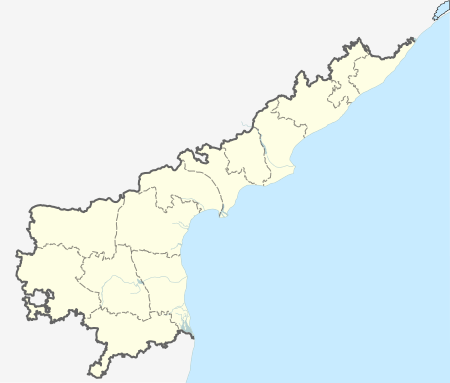Mangalagiri mandal
| Mangalagiri mandal మంగళగిరి మండలం | |
|---|---|
| Mandal | |
|
Mandal map of Guntur district showing Mangalagiri mandal (in green) | |
 Mangalagiri mandal Location in Andhra Pradesh, India | |
| Coordinates: 16°17′16″N 80°45′07″E / 16.2877°N 80.7519°ECoordinates: 16°17′16″N 80°45′07″E / 16.2877°N 80.7519°E | |
| Country | India |
| State | Andhra Pradesh |
| District | Guntur |
| Headquarters | Mangalagiri |
| Government | |
| • Body | Mandal Parishad |
| • Tehsildar | CH.Krishnamurthy |
| Area[1] | |
| • Total | 101.31 km2 (39.12 sq mi) |
| Population (2011)[2] | |
| • Total | 160,303 |
| • Density | 1,600/km2 (4,100/sq mi) |
| Languages | |
| • Official | Telugu |
| Time zone | IST (UTC+5:30) |
Mangalagiri mandal is one of the 57 mandals in Guntur district of the Indian state of Andhra Pradesh. It is under the administration of Guntur revenue division and the headquarters are located at Mangalagiri town.[3][1] The mandal is bounded by Thullur, Tadepalle, Tadikonda, Pedakakani and Duggirala mandals and a portion of the mandal lies on the banks of Krishna River.[4]
History
Until February 1970, Guntur district had only eight taluks. Mangalagiri taluk was formed on 1 November 1977 by re-organising the then existing eight taluks into eleven taluks. On 25 May 1985, mandals were recognised, replacing taluks and firkas.[5]
Demographics
As of 2011 census, the mandal had a population of 160,303. The total population constitute, 80,363 males and 79,940 females —a sex ratio of 995 females per 1000 males. 15,833 children are in the age group of 0–6 years, of which 7,990 are boys and 7,843 are girls. The average literacy rate stands at 72.32% with 104,479 literates.[2]
Governance
Administration
The four villages namely, Krishnayapalem, Nidamarru, Kuragallu (Nerukonda hamlets), Nowluru (Yerrabalem & Bethapudi hamlets) of the mandal are a part of Andhra Pradesh capital city and the mandal is a part of Andhra Pradesh Capital Region, under the jurisdiction of APCRDA.[6] The mandal is controlled by a tahsildar and the present tahsildar is CH.Krishnamurthy.[7]
As of 2011 census, the mandal has twelve revenue villages, fourteen gram panchayats, one town, two out growths and nine villages.[5]:ix[1] Mangalagiri (M) is the only town and Nowlur (OG), Atmakur (OG) are the out growths to Mangalagiri (M).[3][8]
The settlements in the mandal are listed below:
- Atmakur (OG)
- Chinakakani
- Chinavadlapudi
- Kaza
- Krishnayapalem
- Kuragallu
- Mangalagiri (M)
- Nidamarru
- Nowlur (OG)
- Nutakki
- Pedavadlapudi
- Ramachandrapuram
Note: M-Municipality, OG-Out Growth[9]
Poltics
Mangalagiri mandal is one of the 3 mandals under Mangalagiri (Assembly constituency), which in turn represents Guntur (Lok Sabha constituency) of Andhra Pradesh.[10]
Education
The mandal plays a major role in education for the rural students of the nearby villages.The primary and secondary school education is imparted by government, aided and private schools, under the School Education Department of the state.[11] As per the school information report for the academic year 2015–16, the mandal has more than 23,920 students enrolled in over 114 schools.[12][13]
See also
References
- 1 2 3 "District Census Handbook - Guntur" (PDF). Census of India. p. 14,270. Retrieved 29 November 2015.
- 1 2 "Census 2011". The Registrar General & Census Commissioner, India. Retrieved 26 July 2014.
- 1 2 "Guntur District Mandals" (PDF). Census of India. p. 64.107. Retrieved 19 January 2015.
- ↑ "Mandals in Guntur district". aponline.gov.in. Retrieved 28 July 2014.
- 1 2 "Hand Book of Statistics 2013 Guntur District" (PDF). pp. i. Retrieved 9 September 2016.
- ↑ "District wise mandals and villages covered in Krishna and Guntur districts" (PDF). Andhra Pradesh Capital Region Development Authority. Government of Andhra Pradesh. Retrieved 23 September 2015.
- ↑ "List of Tahsildars working in Guntur District as on 19.06.2014" (PDF). Guntur District Official Website. National Informatics Centre. p. 1. Retrieved 23 January 2015.
- ↑ "Sub-District Details of Guntur District". The Registrar General & Census Commissioner, India. Retrieved 24 May 2014.
- ↑ "Abbreviations used". censusindia.gov.in. Retrieved 26 May 2014.
- ↑ "Delimitation of Parliamentary and Assembly Constituencies Order, 2008" (pdf). Election Commission of India. p. 22. Retrieved 11 October 2014.
- ↑ "School Education Department" (PDF). School Education Department, Government of Andhra Pradesh. Retrieved 7 November 2016.
- ↑ "R1.1 SCHOOL INFORMATION".
- ↑ "Student Information Report". Commissionerate of School Education. Child info 2015-16, District School Education - Andhra Pradesh. Retrieved 8 November 2016.
 |
Thullur mandal | Thullur mandal | Tadepalle mandal |  |
| Tadikonda mandal | |
Tadepalle mandal River Krishna | ||
| ||||
| | ||||
| Pedakakani mandal | Pedakakani mandal Duggirala mandal |
Duggirala mandal |
